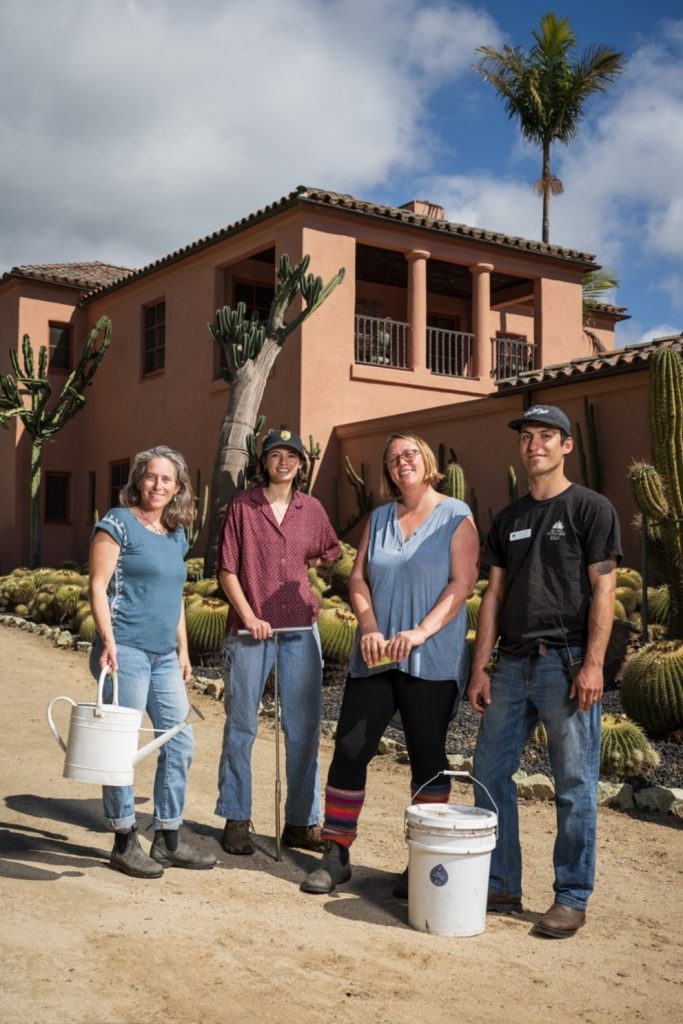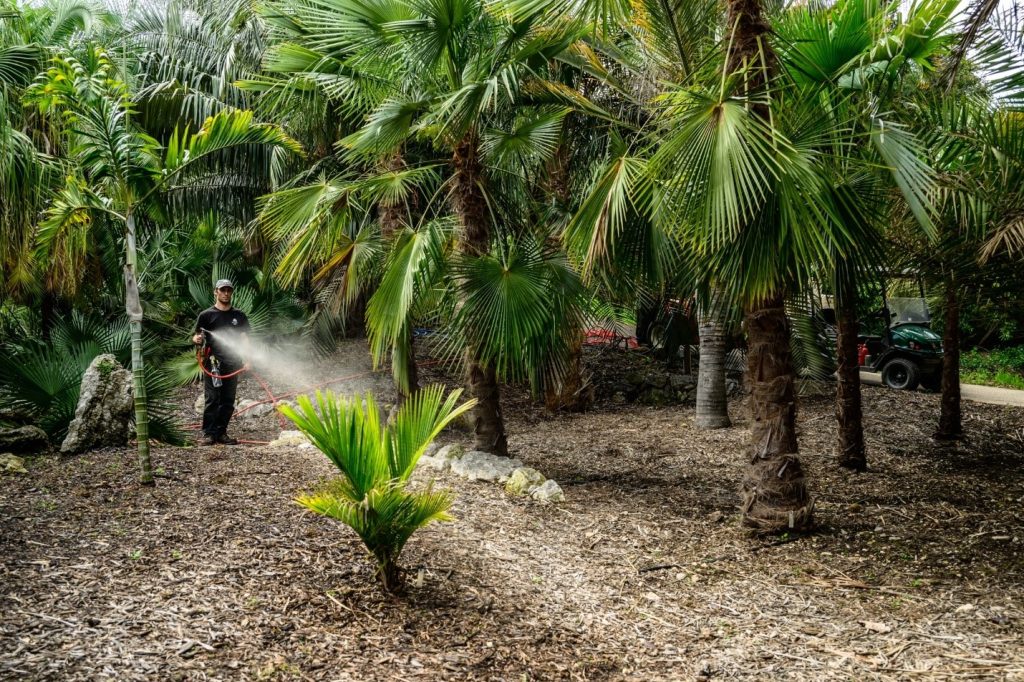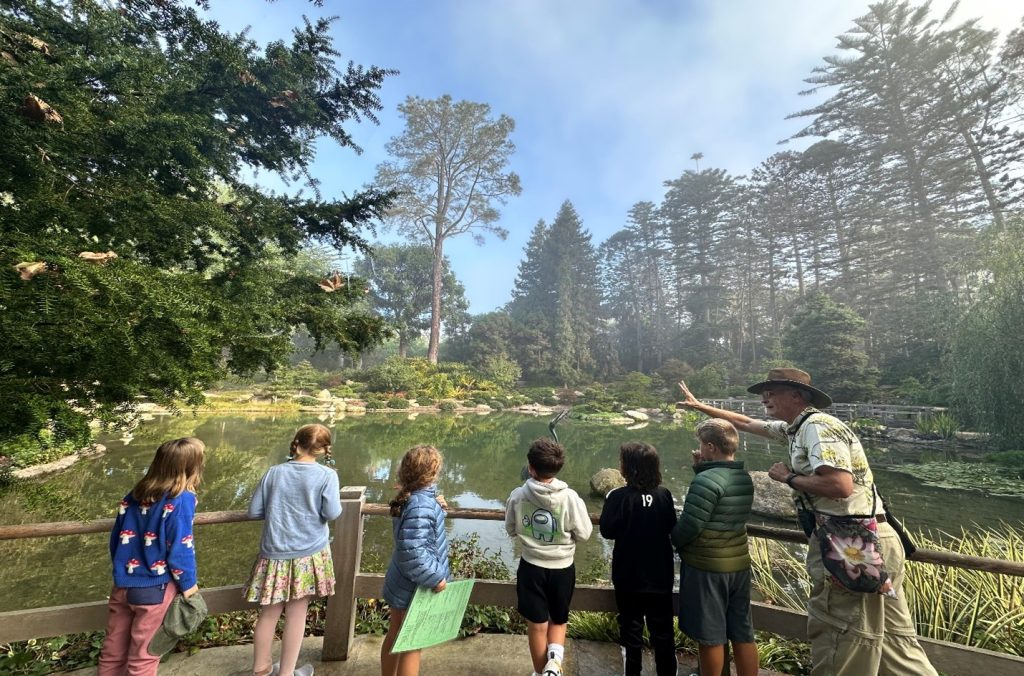Ganna Walska Lotusland: An Evolving Approach to Climate Sustainability

An Ecological Transition
The sustainable horticulture program at Ganna Walska Lotusland began 25 years ago when innovative staff applied evolving ecological practices. This endeavor began as a necessity when traditional fertilizers were failing to enhance Lotusland’s living collections and many plants were showing signs of distress.
In the early 1990s Lotusland utilized a wide range of synthetic fertilizers and pesticides to maintain the garden. Many of these chemicals were detrimental to the overall environment and the health of the plants they were supposed to benefit. Despite the potentially dangerous inputs, the garden still struggled with high instances of pests, diseases, and poor growth.
Drawing on the knowledge of experts in soil ecology, entomology, plant pathology and other fields, Lotusland gardens and grounds staff worked to transform the structure and guiding principles at Lotusland. They worked to move from a conventional model, reliant on synthetic products, to a regenerative approach – slowly phasing in organic fertilizers, creating insectary habitats, and curtailing pesticide use.
With this change of approach, the plants were revitalized and rejuvenated. Twenty-five years later, Ganna Walska Lotusland is still building upon the foundation of its sustainable model by seeking new strategies that will improve the ecology of the garden and reduce environmental impacts.
Thanks to a grant made possible by the generosity of Eric and Wendy Schmidt, Lotusland has been documenting these sustainable horticulture strategies and developing new approaches, with the goal of making this wealth of experience accessible to all. “Sustainability has become a core part of our mission at Lotusland. As one of the country’s first public gardens to implement plant healthcare without pesticides, we are proud to share our methods and time-tested approaches,” shared Executive Director Rebecca Anderson. “This grant has enabled a smooth staff succession, information capture and documentation of critical institutional knowledge and practices, and ultimately will benefit gardens and gardeners well beyond our borders.”

Cross-Sector Collaboration – Keeping It Local
In 2022, Lotusland began a collaboration with Get Hooked Seafood – a for-profit local seafood purveyor centered on developing community partnerships.
Rather than turning their fish scraps and waste into chum or sending it to the landfill, Get Hooked has begun making incredibly high-quality micronutrient-rich hydrolysate fish fertilizer which recharges soil health and supports thriving plants. Co-founder and CEO of Get Hooked Kim Selkoe, Ph.D., reports that “harnessing the power of the sea to nourish our soils is a way to restore a natural land-sea nutrient cycle that was disrupted by coastal development.”
“If you go to Home Depot, you can find fish emulsion garden fertilizer – where fish is basically cooked down to create a fish slurry,” explains Lotusland’s Manager of Sustainability Chris Ziliotto. “Fish hydrolysate is exciting because it’s fermented instead of cooked; you have a lot more intact fatty acids, and a richer product with probiotics.” Get Hooked learned the process of creating fish hydrolysate by working with White Buffalo Land Trust, a hub for regenerative land stewardship and ecological research and education based in Central California.
Most fertilizer products used in botanic gardens are shipped vast distances and it can be difficult to find local fertilizer producers that are making high quality organic products. The fertilizer that Lotusland is replacing with the Get Hooked hydrolysate is a liquid imported from Spain. This represents dozens of gallons transported across thousands of miles annually – which comes with a huge carbon footprint and does not support the local economy. “Lotusland’s partnership with Get Hooked represents ‘the farm-to-table equivalent of fertilizer’,” says Ziliotto.

The Trials
Lotusland is in the trial phases of applying this local hydrolysate fertilizer into the garden. The first trial was completed in Lotusland’s orchard with the Get Hooked hydrolysate being applied to test plots of annual flowers. This initial trial was to make sure there were no issues with phytotoxicity (i.e. no adverse effects on plant growth). There was some concern that heavy metals found in fish would make their way into the soils; however, the test results showed very safe levels of heavy metals with fractions of the legally allowed limit.
The plants in the initial trial grew wonderfully with the new fertilizer. Lotusland is conducting a second trial on a newly installed section of native insectary. “It’s unconventional to use fertilizer on native plants,” says Ziliotto, “this is a great opportunity to really make sure that the hydrolysate can be given to sensitive plants that don’t want an aggressive feed.”
Starting in March 2024, Lotusland will be conducting a year-long, side-by-side experiment comparing the Get Hooked hydrolysate with the soon-to-be phased out Spanish fertilizer. In-garden hydrolysate trials and soil tests will be conducted before initial fertilizer application and after the year is complete to see if there are significant improvements or impacts as a result of this switch.

The Four Pillars of Sustainable Horticulture
The larger mission is to show that this transformation is more significant than just switching to locally sourced fertilizer – that Lotusland is improving upon the practices they’ve been building for the last 25 years. Lotusland aims to showcase this, with plans to build interpretation into the garden in addition to their wider networks of outreach and communication.
“We’re developing onsite programming and content to add to our website alongside a new digital guide with Bloomberg Connects that provide visitors in the garden, and across the globe, insight into how we sustainably manage Lotusland and how these same tools and methods can be applied anywhere,” explains Director of Marketing & Communications Katherine Colin.
To this end, Lotusland has published Partnering with Nature, a technical guide aiming to share the Garden’s sustainable horticulture principles and practices with staff. This is also meant act as a guidepost for other institutions to understand and connect with larger ecological processes and holistic perspectives. The Guide encompasses Lotusland’s approach to sustainable horticulture which is built on four pillars:
- Understand Horticultural Requirements – by emphasizing plant research and providing proper growing conditions, plant health will thrive without reliance on synthetic inputs.
- Foster Habitat – by developing insectary habitat, the Garden fosters a diverse population of insects which act as pollinators, predators to pest insects, and prey to birds and other wildlife. This improved ecology helps balance pest populations, reducing reliance on synthetic products, and improving plant health.
- Build Healthy Soils – healthy soil is a dynamic ecosystem of diverse organisms which provide innumerable ecological benefits. Applications of organic fertilizer, mulches, compost, and compost tea bolster this soil food web.
- Avoid Harmful Practices – certain practices are not compatible with a sustainable approach to horticulture: in particular, the use of synthetic fertilizers and pesticides, and practices that contribute to soil compaction. These detrimental practices add up and negate other pillars. Avoiding them sounds easy enough, but it’s not always simple.

Takeaways for Other Institutions
What makes Lotusland stand out is the incredible diversity supported in the garden. Even with plants from all across the globe, Lotusland is able to make them all grow beautifully, using the holistic sustainable approach that doesn’t require synthetic inputs.
“We recognize that we’re very lucky here in Santa Barbara,” admits Colin. “We have a unique climate that allows everything to grow seemingly magically – and we’re 37 acres. Those two factors, the size of the garden and the unique climate conditions, help us to follow this process.”
Ziliotto details the following suggestions for larger gardens and museum landscapes that wish to transition to holistic management:
- Get creative with your spaces. Put “wasted space” to use by building an insectary comprised of native plants, even if they are not the focus of your collection.
- Increase species diversity to promote ecological interactions that will keep pest populations in check.
- Avoid broad applications of harmful pesticide products and synthetic fertilizers
- Learn to tolerate some pest presence and damage
In other words: Plant native habitats, don’t spray them and expand them across your space to encourage beneficial biology that will take care of your garden’s pest problems for you.
“Gardens are not inherently fragile,” says Ziliotto, “Our collections, as rare as they may be, are living species that have existed for huge amounts of time. The idea that we need to put industrial chemicals and poisons into them to make them grow is nonsensical.”
Lotusland is proud to share Partnering with Nature with Climate Toolkit Members via the following link: https://www.lotusland.org/technical-guide/. Educational visits and behind-the-scenes tours can also be scheduled by contacting the Garden.

Resources:
- University of California Agriculture and Natural Resources (UCANR) – information concerning pests and natural predators.
- Living soil philosophy: largely inspired by the work of Dr. Elaine Ingham who popularized and advanced the notion of “The Soil Food Web” as well as compost and compost tea.
- Insectary plants and native pollinator habitat: Work associated with UC Davis Bee Haven & UC Berkley Urban Bee Lab
- Professor Robbin W Thorp from UC Davis who was Corey Welles’ entomology mentor. He had also exchanged with Dr Gordon Frankie of UC Berkley, who is prominent in the native bee scene.
- Deke Dietrick of Rincon Vitova – whose early insectary program includes five features of integrated pest management.
- Dr. Arthur James Downer – Environmental Horticulture/Plant Pathologist (UCANR)
- Dr Ben Faber – UC Cooperative Extension Ventura County






Recent Comments